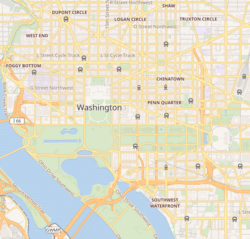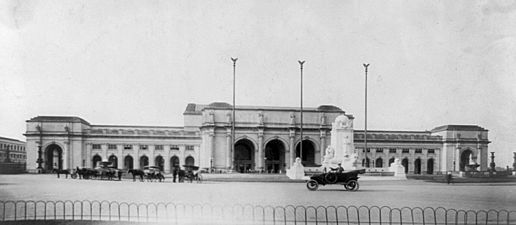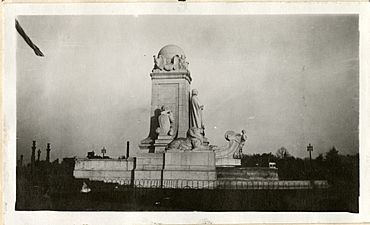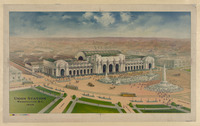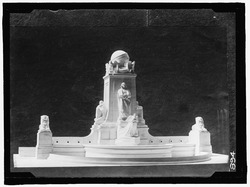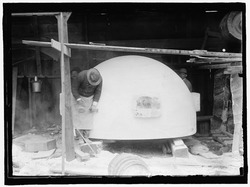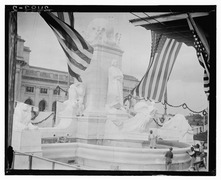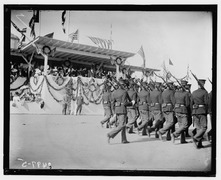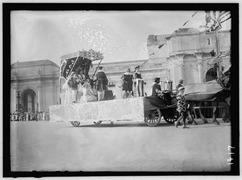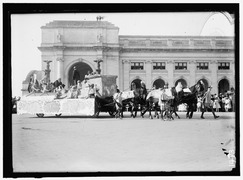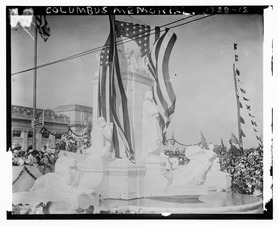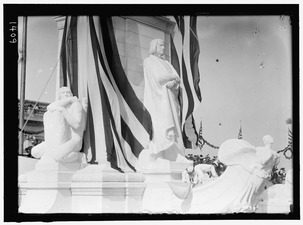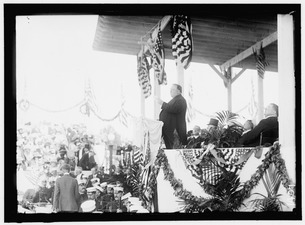Columbus Fountain facts for kids
Quick facts for kids Columbus Fountain |
|
|---|---|
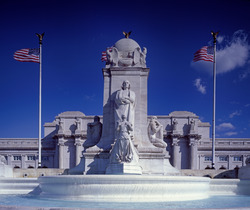 |
|
| Artist | Lorado Taft |
| Year | 1912 |
| Type | Marble |
| Dimensions | 14 m × 20 m × 13 m (45 ft × 66 ft × 44 ft) |
| Condition | Inoperable static display |
|
Union Station Plaza and Columbus Fountain
|
|
| NRHP reference No. | 80004523 |
| Added to NRHP | April 09, 1980 |
| Location | Washington, D.C., United States |
| 38°53′47.04″N 77°0′23.76″W / 38.8964000°N 77.0066000°W | |
| Owner | National Park Service |
The Columbus Fountain, also called the Columbus Memorial, is a large public artwork. It was created by American sculptor Lorado Taft. You can find it at Union Station in Washington, D.C., United States. This fountain is the main feature of Columbus Circle. It honors the famous explorer Christopher Columbus. When it was first shown in 1912, there was a huge three-day celebration in Washington, D.C. Thousands of people from all over the world came to enjoy parades, concerts, and fireworks.
Contents
What the Fountain Looks Like
The Columbus Fountain is shaped like a half-circle with two water basins. In the middle, there's a tall stone column, about 45 feet high. On the front of this column is a large statue of Christopher Columbus, about 15 feet tall. He wears a long cloak and looks straight ahead with his hands together.
Below Columbus, there's the front part of a ship, called a prow. It has a winged figure on it, which stands for the idea of discovery. At the very top of the column is a globe, representing the Western hemisphere. Four eagles are on each corner of the globe, connected by decorative garland.
On the sides of the column, there are two male figures. The figure on the right side is an older man, symbolizing the Old World (like Europe). The figure on the left side is a Native American, representing the New World (the Americas). On the back of the column, there's a round carving (about 3 feet across) showing images of King Ferdinand and Queen Isabella. Two large lions, about 5 feet tall, sit on either side of the fountain's base, guarding it.
The back of the column has a special message carved into it:
- TO
- THE MEMORY OF
- CHRISTOPHER COLUMBUS
- WHOSE HIGH FAITH
- AND
- INDOMITABLE COURAGE
- GAVE TO MANKIND
- A NEW WORLD
- BORN MCDXXXVI
- DIED MDIV
The fountain is located in the middle of the traffic circle right in front of Union Station.
How the Fountain Was Planned
At first, a different type of fountain was planned for the area in front of Union Station. But in 1906, a group called the Knights of Columbus started asking for a memorial to Christopher Columbus. They didn't say exactly where it should be at first.
On March 4, 1907, the 59th United States Congress passed a law. It said that a "suitable memorial to the memory of Christopher Columbus" should be built in Washington, D.C. This law also created a special group, called a Commission, to oversee the project. This group included important people like the Secretary of State and the Secretary of War. They had the power to choose the location, the design, and to manage the building of the memorial. Congress also gave the Commission $100,000 to pay for the project.
Designing the Memorial
In May 1907, the Commission was officially formed. They decided the fountain would be placed in front of Union Station. They then asked artists from America, Italy, and Spain to submit their designs. They wanted to include artists from these countries because America was the land Columbus found, Italy was his home country, and Spain helped him make his journey.
On March 20, 1908, the Commission approved a general plan for the design. The plan described a semi-circular fountain, about 64 feet wide. The main part would be a stone column about 10 feet tall, topped with a globe. In front of this, there would be a statue of Columbus standing at the front of a Spanish ship. Two lions would be placed on the fountain walls.
The design was influenced by another fountain. This one was created by Frederick MacMonnies and shown at the World's Columbian Exposition in Chicago in 1893.
Six sculptors were specifically invited to join the design competition. These included Augustin Querol from Spain, Augustus Revolta and Cesare Zoccni from Italy, and Frederick W. MacMonnies, Daniel C. French, and Lorado Taft from the United States. Lorado Taft was a distant cousin of the Commission's chairman, William H. Taft. Many other sculptors also submitted their ideas.
The models submitted by the artists were put on display in December 1908. The public could view them later, in February 1909. On February 27, 1909, the Commission announced the winner. Lorado Taft won the competition! He was chosen to create the statue of Columbus and all the other sculptures for the fountain. He also received $20,000 for his winning design. The remaining money, $79,000, was used to buy materials like bronze and granite, and to pay for the carving, casting, and installation of the memorial.
Construction of the fountain and its base began on October 31, 1911. The actual sculptures were installed between March and June 1912.
Unveiling and Celebration
There was a lot of excitement for the fountain's unveiling. A special committee was formed to plan a three-day celebration from Friday, June 7, to Sunday, June 9, 1912.
Friday, June 7
On Friday, June 7, members of the Knights of Columbus from all over the world came to Washington. They visited the tomb of George Washington at Mount Vernon. That evening, a public reception was held at the new National Museum (now the National Museum of Natural History). About 4,000 people attended, enjoying music played by the United States Marine Band.
At the same time, an amazing automobile parade took place near the White House. Fifty thousand people watched as cars paraded through the streets.
Saturday, June 8
The main dedication ceremony happened on Saturday, June 8, 1912. It was estimated that 150,000 people would attend. Congress provided extra money for police security, and the Knights of Columbus also contributed funds for decorations and planning.
A huge parade started at 3:00 pm, with about 50,000 people participating. It included military groups like the US Engineers and the Coast Artillery Corps, along with the Navy and Marines. Then came the civic part of the parade, with Knights of Columbus members from different states.
Five large Parade floats followed, showing different parts of Christopher Columbus's story:
- "Reception of Columbus" by King Ferdinand
- "Columbus before the King"
- The "Departure of Columbus" from Europe
- The caravel (ship) Columbus sailed
- The landing in the New World
The parade ended at Union Station Plaza, where President Taft and his guests watched. The unveiling of the artwork happened on a beautiful sunny day. Secretary of State Philander Knox led the ceremony. After speeches and music, the Italian Ambassador, Marquis Luigi Cusani-Confalonieri, pulled the cords to reveal the statue. As the American flag fell away, a battery from the 3rd Field Artillery fired a 21-gun salute. President Taft then gave a formal speech.
That evening, a large banquet was held, and the District Building was lit up. There were also fireworks near the White House, with a large crowd watching the display.
Sunday, June 9
On Sunday, veterans attended a military mass at St. Patrick's Catholic Church. In the evening, a final public concert was held, featuring the US Marine Band.
Columbus Day Celebrations
Every year, Columbus Day celebrations are held at the fountain. These events often include the US Marine Corps Band and a ceremony where wreaths are placed at the memorial.
Condition and Care
The Columbus Fountain was added to the National Register of Historic Places on March 7, 1968. This means it is recognized as an important historical site.
In October 1991, the memorial was spray-painted with graffiti. The National Park Service quickly cleaned it. In March 1994, a survey found that the fountain needed some repairs.
As of 2014, the fountain has had some problems. It has structural issues, and the statues have been painted to hide discoloration. The fountain basins are boarded up because the plumbing doesn't work. In 2016, the fountain was chosen to compete for a grant to help with its restoration.
Images for kids


